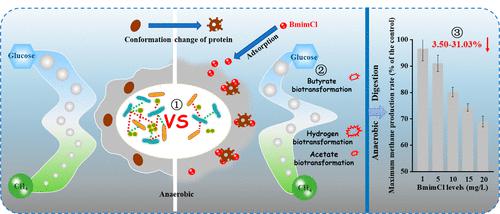当前位置:
X-MOL 学术
›
Environ. Sci. Technol.
›
论文详情
Our official English website, www.x-mol.net, welcomes your
feedback! (Note: you will need to create a separate account there.)
1-Butyl-3-methylimidazolium Chloride Affects Anaerobic Digestion through Altering Organics Transformation, Cell Viability, and Microbial Community
Environmental Science & Technology ( IF 10.8 ) Pub Date : 2023-02-16 , DOI: 10.1021/acs.est.2c08004 Qi Lu 1 , Dandan He 1 , Xuran Liu 2 , Mingting Du 1 , Qing Xu 1 , Dongbo Wang 1
Environmental Science & Technology ( IF 10.8 ) Pub Date : 2023-02-16 , DOI: 10.1021/acs.est.2c08004 Qi Lu 1 , Dandan He 1 , Xuran Liu 2 , Mingting Du 1 , Qing Xu 1 , Dongbo Wang 1
Affiliation

|
1-Butyl-3-methylimidazolium chloride (BmimCl), an imidazolium-based ionic liquid, is considered the representative emerging persistent aquatic pollutant, and its environmental toxicity has attracted a growing concern. However, most of the investigations focused on monocultures or a single organism, with little information available on the complex syntrophic consortium that dominates the complex and successional biochemical processes, such as anaerobic digestion. In this study, the effect of BmimCl at environmentally relevant levels on glucose anaerobic digestion was therefore investigated in several laboratory-scale mesophilic anaerobic digesters to provide such support. Experimental results showed that BmimCl at 1–20 mg/L inhibited the methane production rate by 3.50–31.03%, and 20 mg/L BmimCl inhibited butyrate, hydrogen, and acetate biotransformation by 14.29%, 36.36%, and 11.57%, respectively. Toxicological mechanism studies revealed that extracellular polymeric substances (EPSs) adsorbed and accumulated BmimCl through carboxyl, amino, and hydroxyl groups, which destroyed the EPSs’ conformational structure, thereby leading to the inactivation of microbial cells. MiSeq sequencing data indicated that the abundance of Clostridium_sensu_stricto_1, Bacteroides, and Methanothrix decreased by 6.01%, 7.02%, and 18.45%, respectively, in response to 20 mg/L BmimCl. Molecular ecological network analysis showed that compared with the control, the lower network complexity, fewer keystone taxa, and fewer associations among microbial taxa were found in the BmimCl-present digester, indicating the reduced stability of the microbial community.
中文翻译:

1-Butyl-3-methylimidazolium Chloride 通过改变有机物转化、细胞活力和微生物群落影响厌氧消化
1-Butyl-3-methylimidazolium chloride (BmimCl) 是一种咪唑基离子液体,被认为是具有代表性的新兴持久性水生污染物,其环境毒性日益受到关注。然而,大多数研究都集中在单一培养物或单一生物体上,很少有关于主导复杂和连续生化过程(如厌氧消化)的复杂营养联合体的信息。因此,在本研究中,在几个实验室规模的嗜温厌氧消化池中研究了环境相关水平的 BmimCl 对葡萄糖厌氧消化的影响,以提供此类支持。实验结果表明,1-20 mg/L 的 BmimCl 抑制甲烷产率 3.50-31.03%,20 mg/L BmimCl 抑制丁酸盐、氢气、和乙酸生物转化率分别提高 14.29%、36.36% 和 11.57%。毒理学机制研究表明,细胞外聚合物(EPSs)通过羧基、氨基和羟基吸附和积累BmimCl,破坏EPSs的构象结构,从而导致微生物细胞失活。MiSeq 测序数据表明,响应于 20 mg/L BmimCl,Clostridium_sensu_stricto_1、Bacteroides和Methanothrix分别减少了 6.01%、7.02% 和 18.45%。分子生态网络分析表明,与对照相比,在存在 BmimCl 的消化池中发现较低的网络复杂性、较少的关键类群和微生物类群之间的关联,表明微生物群落的稳定性降低。
更新日期:2023-02-16
中文翻译:

1-Butyl-3-methylimidazolium Chloride 通过改变有机物转化、细胞活力和微生物群落影响厌氧消化
1-Butyl-3-methylimidazolium chloride (BmimCl) 是一种咪唑基离子液体,被认为是具有代表性的新兴持久性水生污染物,其环境毒性日益受到关注。然而,大多数研究都集中在单一培养物或单一生物体上,很少有关于主导复杂和连续生化过程(如厌氧消化)的复杂营养联合体的信息。因此,在本研究中,在几个实验室规模的嗜温厌氧消化池中研究了环境相关水平的 BmimCl 对葡萄糖厌氧消化的影响,以提供此类支持。实验结果表明,1-20 mg/L 的 BmimCl 抑制甲烷产率 3.50-31.03%,20 mg/L BmimCl 抑制丁酸盐、氢气、和乙酸生物转化率分别提高 14.29%、36.36% 和 11.57%。毒理学机制研究表明,细胞外聚合物(EPSs)通过羧基、氨基和羟基吸附和积累BmimCl,破坏EPSs的构象结构,从而导致微生物细胞失活。MiSeq 测序数据表明,响应于 20 mg/L BmimCl,Clostridium_sensu_stricto_1、Bacteroides和Methanothrix分别减少了 6.01%、7.02% 和 18.45%。分子生态网络分析表明,与对照相比,在存在 BmimCl 的消化池中发现较低的网络复杂性、较少的关键类群和微生物类群之间的关联,表明微生物群落的稳定性降低。






























 京公网安备 11010802027423号
京公网安备 11010802027423号